Cosmology
1/43
There's no tags or description
Looks like no tags are added yet.
Name | Mastery | Learn | Test | Matching | Spaced |
|---|
No study sessions yet.
44 Terms
What are the three equations for Orbital motion?
1) Fcentrifugal = FGravity
2) mV2/R = GMm/R2
3) V2 = GM/R
What is the Friedmann equation and it’s derivation?
sS
What is the Planck Era, along with the temperature and time frame?
T>1032K, t<10-44s
Above the Planck temperature the four fundamental forces are assumed to operate on the same scale. General Relativity no longer provides an appropriate description of gravity and a theory of Quantum Gravity is needed. As we don’t yet have such a theory, we can’t say any more about this epoch.
What is the Quark Era, along with the temperature and time frame?
(1032 K > T > 1028 K), (10-44s < t < 10-4 s)
This epoch begins when gravity separated from the other forces and can thenceforth be treated by GR. At the highest temperatures a GUT is required to describe the interaction of the quarks and leptons as the strong, weak and electromagnetic interactions are still unified. A process called “baryogenesis” is presumed to occur at a temperature around 1028 K which results in a very small excess of quarks over anti quarks (3 parts in 109). At this point the strong interaction separated from the weak and electromagnetic interactions, from that point on being described by QCD and the electroweak theory. At 1012 K a phase transition is believed to occur with the quarks becoming bound into baryons and mesons, and their antiparticles.
What is the Lepton Era, along with the temperature and time frame?
(1012K > T > 1010K), (10-4s < t < 1s)
During this epoch the Universe is full of leptons (e+/e- ), hadrons (n/p) and neutrinos (𝑣/𝑣̅) all interacting through the weak and electromagnetic interactions. These interactions ensured that the plasma was in good thermodynamic equilibrium. Towards the end of this period the neutrinos (which don’t feel the electromagnetic interaction) decoupled as the weak interaction strength was falling very rapidly with decreasing temperature.
What is the Photon dominated era, along with the temperature and time frame?
1010 < T < 16,500K, 1s < t < 1011s
As the temperature fell below the equivalent of 1MeV the photons were no longer able to create e+-e- pairs and the electrons and positrons began annihilating, injecting more photons into the photon background. Between 10 K and 10 9 K primordial nucleosynthesis occurred and created the light elements (H, He, and Li).
What is the matter dominated era, along with the temperature and time frame?
16,500K > T > 2.725K, 1011s < t < ~14 billion years
As the Universe expands, the radiation energy density falls off faster than the matter density and a point is reached where the expansion becomes dominated by matter. At T ~ 3000K atoms form creating neutral matter and the photons are free to propagate through the Universe. This is the last point at which matter and radiation interacted strongly. The matter starts to clump to form the structures that we see today. The radiation is stretched by the expansion with the black body spectrum cooling over time until it reaches the present temperature of 2.725K
What are the two ways to view Λ? (The cosmological constant)
As an energy permeating the whole of space
As a fluid filling all of space
Give all the R against t graphs for k = -1, 0, 1 and Λ < 0, Λ = 0, 0 < Λ < ΛE, Λ = ΛE, A > ΛE?
GRaph
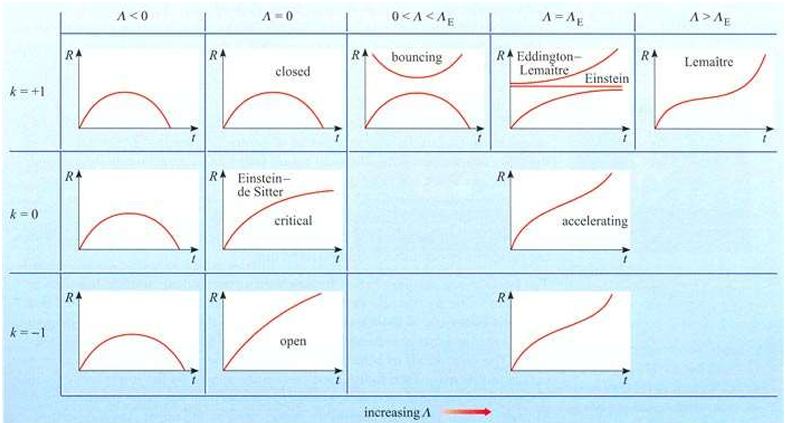
What is the strongest current evidence for the big bang?
The consistency of predictions in terms of relative nuclide abundances and the total quantity of observable matter are remarkable and the strongest evidence we have for the Big Bang theory.
However recently there is some suggestion that the predicted Li-7 abundances may not be correct (however this is not conclusive and could be due to poor observations/ inaccuracies in reaction rates used in simulations.
When does Cosmic Microwave Background radiation date back to and at what temperature?
The best estimate is T ~ 3000K, corresponding to t ~350,000 years
Using a simple approximation for recombination at the CMB event, how would you calculate the temperature and what is wrong with these calculatations?
Recombination doesn’t happen to all atoms instantaneously. More sophisticated calculation tracks gradual decrease in the ratio of the ion to neutral atom number density (Saha Equation)
10^-9 is the number to use as you have a billion times more photons than protons
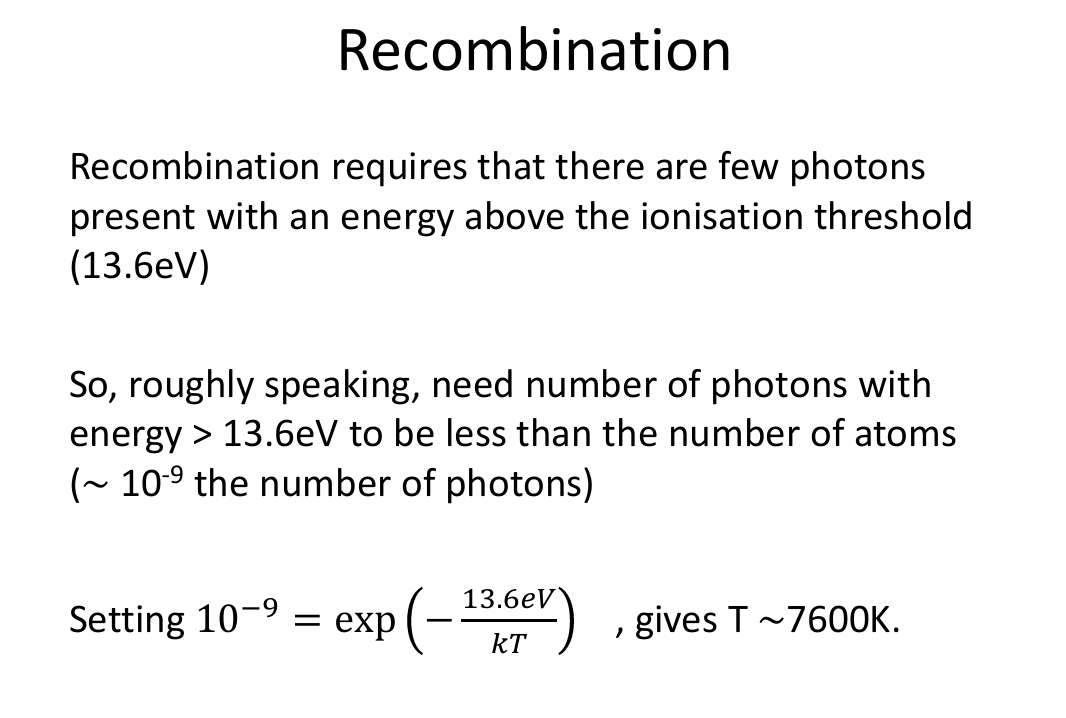
Why doesn’t the fact that galaxies are moving away from us at greater than the speed of light matter?
This is not actually in disagreement with the special theory of relativity, since this applies only to inertial reference frames. Essentially it prohibits information transfer at greater than c, and local motion at greater than c. It does not however prohibit two causally disconnected regions of space that are accelerating away from one another from moving away from one another faster than the speed of light – nor does it imply that some galaxies effectively have an infinite energy and momentum associated with them!
What red shift means that something is moving away from us faster than the speed of light?
Anything with a redshift (z) > 1.4 is currently moving away from us at greater than the speed of light
This object is 13.3 billion light years away- so how can the last scattering surface be 46 billion light years away?!
What is being quoted is the so-called “light-travel distance” which is just the length of time the light from an object has been propagating multiplied by c.
What is the basic overview of the flatness problem?
The flatness problem suggests that the Big Bang had a value of Ωtot that was incredibly close to 1 (to better than one part in 1062 !!). This is very improbable.
What is the basic overview of the horizon problem?
Horizon problem suggests that the Big Bang must have been remarkably uniform at t=0, as evidenced by the similarity of causally disconnected regions in the surface of last scattering that acts as the source of the CMB.
(Not enough time according to the classic big bang model for each part of space to come into thermal equilibrium with each other)
Why does inflation theory solve the horizon problem?
Because of the vast increase in size during inflation, region which had reached thermal equilibrium grows in size much greater than the horizon distance.
So our visible Universe was once a tiny region (pre-inflation) which was small enough to be in equilibrium.
Why does inflation theory solve the flatness problem?
If you have a curve surface and you make it bigger, it become smoother when observed from a given scale.
Basically, the vast size increase greatly reduces local curvature
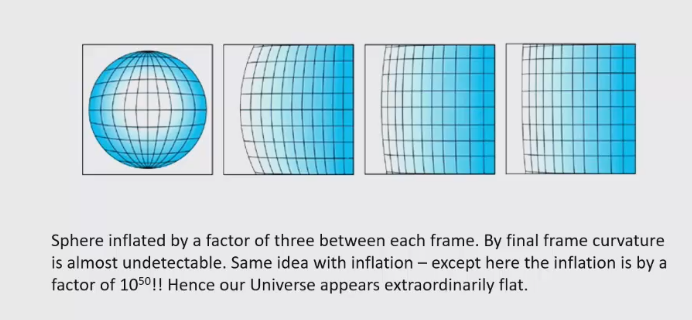
What causes the peaks in the Planck anisotropy spectrum for CMB?
It is thought that these peaks are caused by acoustic oscillations of matter in the early Universe at the time of de-coupling – these oscillations arise due to a complex interplay between dark matter, baryonic matter and photon pressure.
State and describe the Matthew effect. AKA The gravitational instability
Once radiation has decoupled from matter, regular matter is free to fall into the gravitational wells present in the dark matter distribution.
Once the universe becomes matter-dominated, the over-dense regions expand less rapidly than the universe as a whole
If their density is sufficiently great, they will actually start to collapse and become gravitationally bound objects
These dense regions will, in addition, start to draw matter to themselves from the surrounding underdense regions
This marks the starting point of the formation of galaxies, clusters, and superclusters...
What is the evidence for inflation theory?
Solves the horizon problem
Solves the flatness problem
Solves the magnetic monopole problem
Provides an explanation for the formation of structure
What does the cosmological constant represent?
It is a repulsive force acting upon space
It is related to the energy density of the vacuum/acting as a negative pressure possessing “fluid” filling the universe
What is meant by a ”bouncing” universe?
In a bouncing universe, the vacuum energy resists the complete collapse causing it to turn around and re-expansion to occur. This will cycle through further plans of collapse/expansion.
In the original Einstein Universe what was the role of the positive cosmological constant?
In the Einstein static universe, the universe is held in statis by a cosmological constant which acts to resist the gravitational collapse
What behaviour may be expected in an initially expanding universe with k=+1 and a value of the cosmological constant which is positive but less than that prescribed by Einstein?
In this case the cosmological constant, though present and +ve will be unable to resist the gravitational collapse, however, this situation will then become a bouncing universe
Define the Cosmological Principle
The Universe is homogenous and isotropic. AKA looks the same at all points and looks the same in all directions respectively.
What are the candidates for dark matter?
MACHOs (Massive Compact Halo Objects)
Cold Dark Matter
Warm Dark Matter
Hot Dark Matter
Mass in extra dimensions
Or a modified theories of gravity
What are MACHOs (MAssive Compact Halo Objects?
Consists of normal baryonic matter that emits little EM radiation
They include neutron stars, black holes and brown dwarfs with associated planets
Search involves gravitational lensing
Conclusion is there is not enough MACHOs mass to satisfy mass deficit
What is Cold Dark Matter?
WIMPS (Weakly Interacting Massive Particles) and axions are the leading Dark matter candidate
Short mean free path for particles in early universe, therefore “cold”
Structure formation is bottom up
Thought to seed structures (galaxies) of the correct scale in the early universe
Cold dark matter is yet to be identified in experiments
What is Warm Dark Matter?
Refers to particles that had a free-streaming length comparable to a proto-galaxy in the early universe
Bottom up formation for galactic clusters, top-down for structures smaller than a dwarf galaxy
Candidate particles, eg Sterile Neutrino, are not predicted by particle physics models
What is Hot Dark Matter?
Refers to dark matter that had a free-streaming length significantly greater than the size of a proto-galaxy
Top-down formation
Observations strongly conflict with top-down evolution, therefore hot dark matter is ruled out by most physicists
What are the three approaches for the detection of the cold dark matter candidate WIMPS?
Annual modulation
Looking for specific magnitude of recoil
Looking for specific direction of recoil
What is annual modulation?
Detected signal expected to vary slightly due to earth’s motion through the Halo.
Such modulations are one of the key signatures looked for in all direct detection experiments.
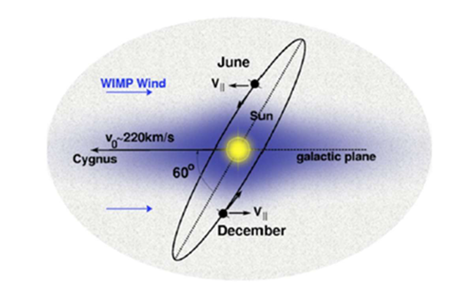
What are the different types of detectors for WIMPS (cold dark matter)?
Cryogenic crystal detectors
Noble gas scintillators
Crystal scintillators
Bubble chambers
What are indirect detection methods from WIMPS (cold dark matter)?
Dark matter particle annihilate and form “ordinary” particles that are detectable
Typically experiments look at regions of the sky that expected to be rich in dark matter, eg. galactic centre and halo, and dwarf galaxies
How to cold dark matter detectors for WIMPS based on production work?
Dark matter is produced in an accelerator
Normal matter particles are observed
Missing energy and momentum is measured
Repeated deficits at similar energies might indicate the presence of dark matter particle formation
What is the observational evidence for dark matter?
Discrepancy between expected and observed stellar velocities in the galaxy rotation curves
Gravitational Lensing: Greater bending of light than visible mass explains
Large-scale structures: Patterns require more matter than visible
How does the scale length of structures in our universe inform our selection of dark matter candidates?
As the free-streaming length of a Dark Matter particle in the early universe is proportional to the scale of the proto-structure produced.

Define the terms in The Friedmann equation?
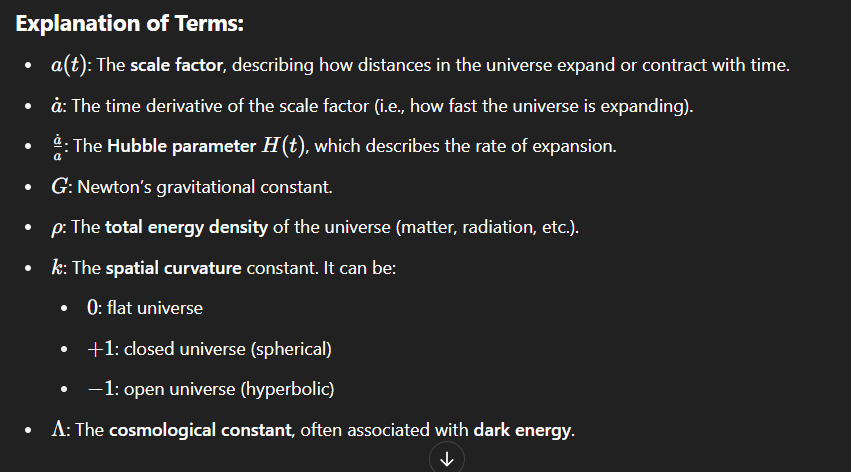
What is the Friedmann equation used for in Cosmology?
It predicts the evolution of the scale factor of the universe
It is used in combination with the fluid equation and equation of state, which describes the way the universe expands, contracts or remains in a steady state
What is meant by the Hubble Time?
The Hubble Time is a predicted age of the universe
Assumes linear expansion from t = 0
Therefore age of the universe equals t0 = 1/H0
Discuss how the use of a changing expansion rate in a model of our universe can help produce results that are in better keeping with observations.
The models must be old enough contain the oldest observed stars
Therefore H (Hubble Constant) must increase with time
This requires Λ however to be plausible
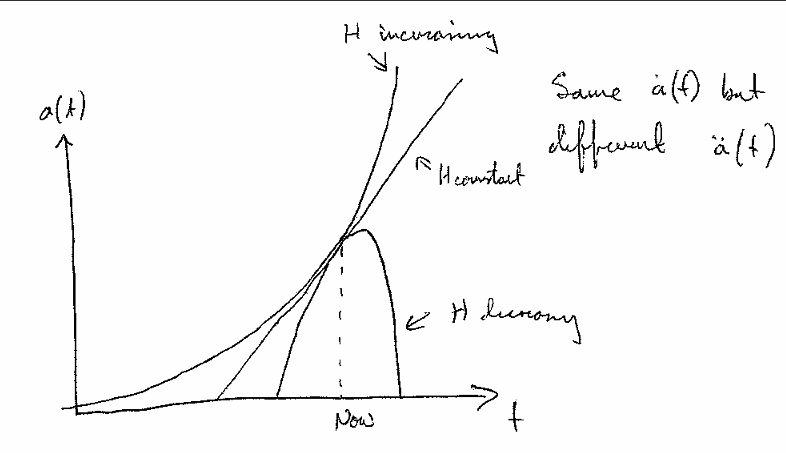
State briefly what the theory of Inflation is, in the context of the Cosmology of the early universe.
Inflation is a period in the early universe during which the scale factor was accelerating
Thus, the universe expanded massively in a short time